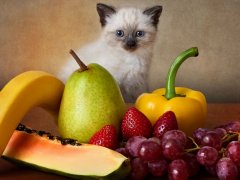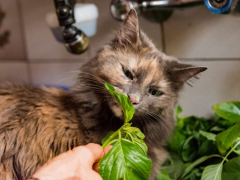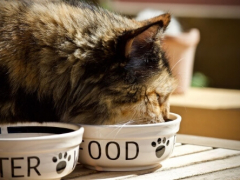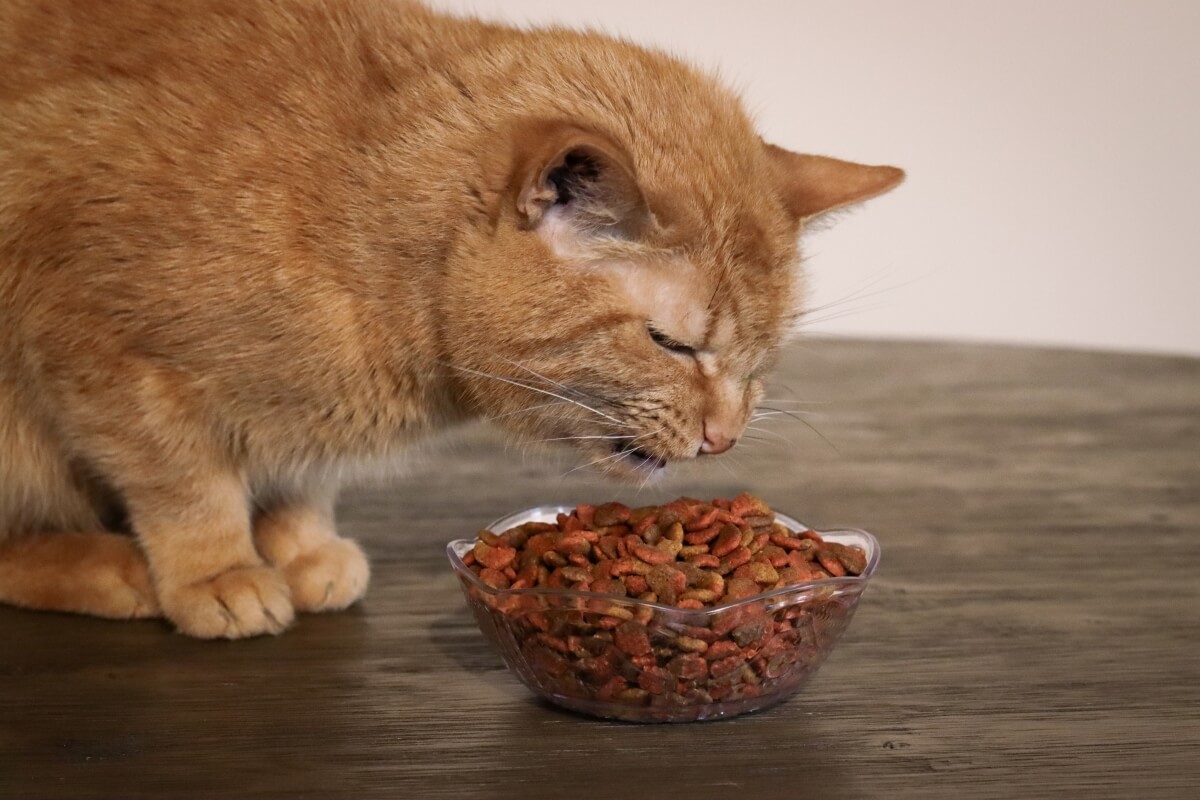
Kirsten McCarthy / Cats.com
Your cat may have their own list of ingredients they turn their little nose up at. But as a feline nutritionist, my standards for food quality are a little more rigorous. The worst cat food ingredients either don’t contribute nutritional value or may actively put your cat’s health at risk.
While every cat is unique in terms of preferences and nutritional needs, there are certain ingredients all cats should avoid. After delving into the scientific evidence for and against the most controversial cat food ingredients, I’ve compiled the top 10 ingredients you should avoid when shopping for cat food.
Potentially Harmful Cat Food Ingredients
A quick scan through the list of ingredients on a cat food label can tell you a lot about the quality of the product. This list will help you understand when to put a low-quality product back on the shelf.
1. Artificial Color
Humans often “eat with their eyes” first, but most pets don’t. For cats, it’s the smell that determines if a food is worth tasting. Manufacturers of inexpensive cat foods like Purina often suggest that artificial color in cat food gives their product “a more appealing and appetizing appearance.”[1] The question is: appealing and appetizing for whom?
Even if your cat is blind, they know with a single sniff whether they’re going to like what’s in their bowl. Coloring agents in cat food aren’t just largely unnecessary—there’s concern some synthetic varieties may be harmful. We recommend steering clear of artificial colors when natural alternatives like turmeric and beetroot are effective.
Artificial dyes like Red #40, Blue #2, and Yellow #5 and #6 have been linked to serious health effects in humans and even in some rodent studies.[2] That said, more research is needed to determine their effects on cats. Keep in mind that synthetic coloring agents don’t always have numbers, either. Iron oxide, for example, is often used to give cheap cat foods a red, meaty color.
2. Artificial Flavor
Aroma is what brings your cat to their dish and the flavor is what makes them stay. Cats are obligate carnivores and generally prefer the flavor of meat over grains. But pet food manufacturers have all kinds of tricks to make plant-based foods taste more like the meaty food your cat craves.
Flavoring agents can be tricky to identify in pet foods, except when they’re called out with the word “flavor.” Chicken liver flavor, for example, is a synthetic flavor additive. Something like sodium nitrate is less obvious. It’s used as both a color and flavor enhancer in commercial cat foods in the US, though other countries have banned it due to potential carcinogenic effects.
Another controversial flavoring agent is animal digest, which is derived from hydrolyzed animal tissue. What type of animal’s tissue? They don’t have to say. Animal digest doesn’t automatically indicate poor food quality, but because the source isn’t specified, safety could be a concern.
3. Carrageenan
Derived from red seaweed, carrageenan is a thickening agent often used in gravy-style wet cat foods. It also acts as an emulsifier to help create a smoother texture. While it is considered safe by the FDA, more studies are needed. That’s because degraded carrageenan is known to cause inflammatory side effects, gastrointestinal ulceration, and poor gut health in animals.
Degraded carrageenan isn’t actually the type used in pet food, but no definitive data is currently available on the safety and effects of carrageenan. Studies have shown that, when added directly to liver and colon cells, even food-grade carrageenan causes inflammation. Because carrageenan isn’t absorbed by the intestines (but may reach cells in the colon), it is unknown whether the effects would be harmful, like degraded carrageenan.[3]
4. Highly Refined Grains
While a species-appropriate diet for cats is meat-based, veterinary nutritionists suggest nutrient-rich plant foods can play an important role in a balanced feline diet. Whole grains and low-starch vegetables are generally considered digestible for cats and can provide valuable nutrition. Highly processed grains? Not so much.
The wheat and corn used in cat food are typically refined—they’ve been processed to separate out the nutrient-rich bran and germ. Low-quality cat foods rely heavily on ingredients like wheat flour and ground corn, which are often used as inexpensive fillers to bulk up the product.
Refined grains are also used as an inexpensive source of protein. Corn gluten meal and wheat gluten are prime examples. When ingredients like these appear before animal protein on a cat food label, the food may not be species-appropriate. It’s also worth noting that
5. Legumes
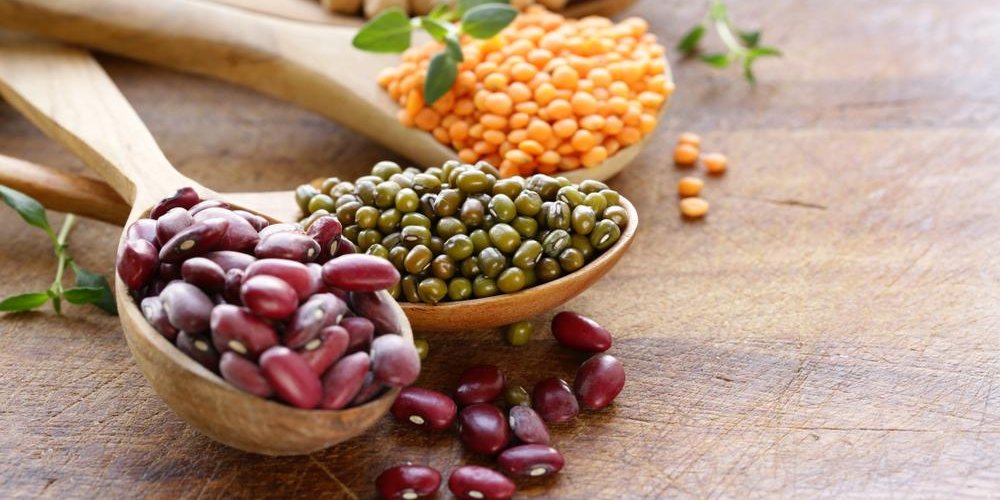
Legumes do not make an appropriate nutritional foundation for feline diets. Dream79 / Shutterstock.com
Legumes came to the forefront of the pet nutrition discussion in 2018 when the FDA launched an investigation into a potential link between grain-free diets and dilated cardiomyopathy (DCM) in pets. Over the next few years, several updates made it clear that any potential association between diet and DCM is a complex issue. The controversy did, however, lead to increased scrutiny of boutique companies, exotic ingredients, and grain-free diets (BEG) pet food products.[5]
This scrutiny led to a new trend in pet food. Rather than grain-free diets, manufacturers are starting to push legume-free diets. Our experts agree that legumes are not an appropriate nutritional foundation for feline diets.
Like all plants, legumes contain lectins, which help defend the plant against pests and microorganisms. Lectins can trigger inflammation and they resist digestion. More concerning, however, is the issue of anti-nutrients. , which can bind to certain nutrients, like calcium and iron, and reduce their absorption in your cat’s body. Soaking legumes prior to cooking can reduce phytic acid content, but this isn’t usually part of pet food processing.[6]
6. PFAS
In addition to adding preservatives directly to pet food, some manufacturers treat the packaging to increase shelf life. Some of the most potentially dangerous such substances for cats are called per- and polyfluoroalkyl substances or PFAS. When applied to pet food packaging, PFAS slows the oxidation of fats and helps protect the product against moisture.
Though the term PFAS may be unfamiliar, you’ve probably heard of Teflon—it’s the same thing. The problem with PFAS is that they’re what the Environmental Working Group (EWG) calls “forever chemicals.” They don’t break down in the environment and they remain in the body for years, decades even, potentially contributing to issues like infertility, kidney problems, and testicular cancer.[7]
In 2022, the EWG identified PFAS on pet food packages from seven major brands , including Purina, Blue Buffalo, Iams, and Rachael Ray Nutrish. Since then, numerous US states have banned the use of PFAS in pet food packaging.[8]
7. Soy Products
When it comes to fillers in cheap cat food, these three are often lumped together: corn, wheat, and soy. Soy products like soybean meal are often used as an inexpensive source of protein. Not only are plant proteins less biologically valuable than animal products, but soy in particular presents two potential issues for cats.
Also Read: Is Plant Protein Good for Cats?
Like legumes, soy products contain phytic acid. Foods that contain a lot of soy may be difficult for cats to digest and the phytic acid may impair nutrient uptake. The bigger risk, however, is the high concentration of isoflavones found in soy. Isoflavones are a type of plant-based estrogen or phytoestrogen. They mimic the effects of natural hormones and can lead to negative health effects. Specifically, . Soy products can also be very harsh on a cat’s liver.[9]
8. Sweetener
As a predator, your cat’s senses are much more highly attuned than your own—with the exception of their sense of taste. While humans have about 9,000 taste buds, cats have fewer than 500.
Cats evolved a particularly strong sense for bitter tastes—possibly to protect themselves from toxic and poisonous materials—but they have absolutely no ability to detect sweetness. They simply lack the taste receptors for it. As such, sweeteners like cane sugar and molasses serve no purpose in cat food.
There’s little risk of sugar in cat food contributing to diabetes, many sweeteners are calorie-dense and nutrient-poor. Overfeeding highly sweetened cat food could contribute to unhealthy weight gain, and obesity in cats is strongly linked with multiple health problems and a shortened lifespan.[10]
9. Synthetic Preservatives
To increase shelf life, most commercial cat foods are preserved in some way. Canned cat food is cooked in hermetically sealed containers, rendering the product sterile. Antioxidants are often added as preservatives to dry cat food. They help prevent the oxidation of fats and the breakdown of water-soluble nutrients.
Natural preservatives, like mixed tocopherols and rosemary extract, are safe in pet foods, but some synthetic preservatives can be dangerous. The worst offenders are butylated hydroxyanisole (BHA) and butylated hydroxytoluene (BHT). These chemicals have been linked to allergic reactions as well as kidney and liver damage in cats when given at high doses.[11] And studies show that BHA is a potential carcinogen.[12]
Ethoxyquin, a chemical preservative initially registered as a pesticide, is approved by the FDA for use in pet foods but has been banned in Europe and Australia. Scientific evidence on the potentially harmful effects of ethoxyquin is inconclusive but it remains a controversial ingredient.
10. Vitamin K3
Vitamin K is required for normal blood clotting. Because bacteria in the large intestine synthesize a natural form of it (vitamin K2 or menaquinone), most cats don’t require significant amounts of dietary vitamin K and deficiencies are uncommon. The most common cause of acute Vitamin K deficiency in cats is poisoning from consuming rodenticide.
A synthetic form of vitamin K, vitamin K3, has two to three times the activity than the naturally occurring vitamin. Often listed as menadione sodium bisulfite complex (MSBC) or simply menadione on pet food labels, it’s sometimes used as an inexpensive vitamin K supplement. Because cats have such low needs for dietary vitamin K, high doses due to formulation errors can be toxic.
One source pointed out in 2020 that MSBC was only initially recommended by AAFCO for use in poultry feed, not pet food.[13] Since then, an Association of American Feed Control Officials or AAFCO-sponsored panel of experts has reviewed scientific evidence and released a statement concluding that MSBC is safe for dogs and cats. Our experts believe the controversy surrounding this synthetic supplement and the dangers of vitamin K toxicity still warrant caution.[14]
The Cats.com Fishy Five
You may have heard of the Dirty Dozen. It’s a list that the EWG releases each year detailing the 12 fruits and vegetables that are covered with the most pesticide residues.[15] Well, now we’re bringing you the Cats.com Fishy Five.
In addition to the 10 worst cat food ingredients discussed above, here are five more our experts recommend thinking twice about:
1. Fish
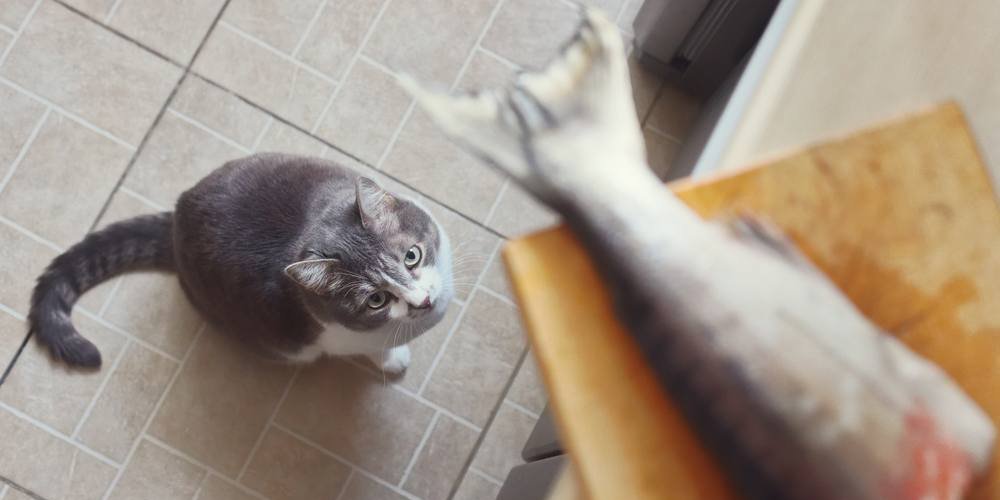
Fish is less species-appropriate for cats than other protein sources. PakulinSergei / Shutterstock.com
Though rich in amino acids and healthy fats, fish is less species-appropriate for cats as proteins like rabbit and poultry. This is because domestic cats evolved from desert-dwelling ancestors who subsisted largely on small prey like rodents and birds. It does, however, provide the essential amino acids your cat needs as well as plenty of skin- and coat-supporting omega-3 fatty acids.
The two primary concerns with fish-based cat food are the risk of food allergies and mercury poisoning. While food allergies in cats are rare, they’re usually triggered by common proteins like chicken, beef, dairy, and fish.
Mercury is primarily a concern with large species of fish that consume other fish. We recommend cat food derived from small fish like skipjack tuna as a safer choice than foods utilizing larger species like albacore or yellowfin tuna. My cat loves the aroma and taste of skipjack tuna.
2. Grains
Though feline anatomy is optimized for processing animal products, research suggests cats can digest carbohydrates and utilize glucose for energy. After all, wild cats often consume small amounts of plant matter in the stomach contents of their prey. That said, digestibility and nutritional value are key.[10]
Whole grains like brown rice and whole-grain oats are preferable to refined grains like corn and wheat. They’re rich in fiber and micronutrients and contain some amino acids as well. I prefer to buy cat food made primarily with animal ingredients, but nutritious and digestible plant foods like whole grains are not harmful.
3. Gum Thickeners
Starch is required for the extrusion of dry cat food but wet cat food formulas more often utilize plant extracts called gums. Gums like guar gum and xanthan gum help keep the ingredients from separating during manufacturing.
Guar gum, derived from guar bean, is technically a type of fiber. So, while not inherently harmful, too much of it can trigger changes in a cat’s stool. Some cats develop loose stools or have more frequent bowel movements when eating cat food thickened with guar gum.
Xanthan gum is a polysaccharide derived from the fermentation of sugar by Xanthomonas campestris bacteria. Used as a binder and thickener like guar gum, xanthan gum also helps wet cat food retain its moisture and texture. Some cats are sensitive to xanthan gum and it may trigger diarrhea or vomiting.[16] There is also some concern that the gum can stick to a cat’s teeth, promoting the growth of bacteria that cause dental problems in cats.
There is insufficient evidence to confirm any long-term harm caused by gum thickeners, but anecdotal evidence suggests these ingredients may trigger digestive upset in some cats. I recommend monitoring your cat’s digestion when feeding products thickened with gums and consult your veterinarian if problems arise.
4. Animal By-Products
The term by-product sounds scary but not all by-products are bad. Animal by-products are simply the parts of the animal that aren’t considered fit for human consumption. As defined by AAFCO, animal-sourced by-products may include organs, blood, and bone but not hair, horns, teeth, or hooves.[17]
Though these ingredients may not sound appetizing, meat by-products can provide biologically appropriate protein, fat, and essential nutrients for your cat. The trouble is with the non-specific term “meat.”
Manufacturers aren’t required to specify which animal meat by-products are sourced from and the nutritional makeup may vary from one batch to another. While I don’t hate a cat food recipe exclusively for containing these ingredients, products that rely heavily on animal by-products often have other marks against them.
5. Plant Oils
Fat is an essential part of a balanced diet for cats but, like protein, it’s most biologically valuable when it comes from animal sources. Unfortunately, plant ingredients are cheaper than animal products, so many cat foods rely on plant oils as the primary source of added fat.
The problem with plant oils is that cats lack the enzymes needed to convert plant-derived fats into the essential fatty acids they need. While plant oils may be rich in polyunsaturated fatty acids (PUFAs) including omega-3s, they’re not in a form your cat can utilize as easily as salmon oil, for example.
There is also evidence to suggest that excess PUFA intake in mammals increases Vitamin E requirements.[18] Cats with vitamin E deficiency, a fat-soluble vitamin, may lead to muscle weakness, cardiac dysfunction, and liver hepatitis. High inclusions of plant-sourced fats are weighed against other nutritional markers in our cat food evaluations.[19]
No commercial cat food product is perfect but that makes it all the more important to equip yourself with knowledge. As a cat owner, the best thing you can do for your cat is choose the safest, most biologically appropriate diet you can consistently afford.
-
Kobylewski S, Jacobson MF. Toxicology of food dyes. International Journal of Occupational and Environmental Health. 2012;18(3):220-246. doi:10.1179/1077352512z.00000000034
-
Barbara Borsani, Raffaella De Santis, Veronica Perico, Francesca Penagini, Erica Pendezza, Dario Dilillo, Alessandra Bosetti, Gian Vincenzo Zuccotti, and Enza D’Auria. The Role of Carrageenan in Inflammatory Bowel Diseases and Allergic Reactions: Where Do We Stand? Nation Library of Medicine. Published online September 27, 2021.
-
Center for Veterinary Medicine. Melamine pet food recall of 2007. U.S. Food And Drug Administration. Published September 4, 2018.
-
Center for Veterinary Medicine. FDA investigating potential connection between diet and cases of canine heart disease. U.S. Food And Drug Administration. Published July 12, 2018.
-
Wang R, Guo S. Phytic acid and its interactions: Contributions to protein functionality, food processing, and safety. Comprehensive Reviews in Food Science and Food Safety. 2021;20(2):2081-2105. doi:10.1111/1541-4337.12714
-
PFAS Chemicals | Environmental Working Group. EWG. Published March 14, 2023.
-
Wall T. Potential toxins found on dog and cat food packaging. Petfood Industry. Published November 9, 2022.
-
Redmon, J. M., Shrestha, B., Cerundolo, R., & Court, M. H. (2015). Soy isoflavone metabolism in cats compared with other species: urinary metabolite concentrations and glucuronidation by liver microsomes. Xenobiotica, 46(5), 406–415.
-
Verbrugghe, A., & Hesta, M. (2017). Cats and carbohydrates: the carnivore fantasy? Veterinary Sciences, 4(4), 55.
-
National Toxicology Program. (2021, December 21). Butylated hydroxyanisole. 15th Report on Carcinogens - NCBI Bookshelf.
-
Thakore, K. N. (2014). Butylated hydroxytoluene. In Elsevier eBooks (pp. 583–584).
-
Thixton, S. (2020, April 21). The new argument on Menadione Sodium Bisulfite Complex.
-
Recommendations for Use of Menadione Sodium Bisulfite Complex (MSBC) in Animal Feed. Association of American Feed Control Officials.
-
Environmental Working Group. (n.d.). #DirtyDozen Fruits and Vegetables with the Most Pesticides – @EWG’s Shopper’s Guide to Pesticides in ProduceTM.
-
Additives, E. P. O., Bampidis, V., Azimonti, G., De Lourdes Bastos, M., Christensen, H., Dusemund, B., Durjava, M. F., Kouba, M., López‐Alonso, M., Puente, S. L., Marcon, F., Mayo, B., Pechová, A., Petkova, M., Ramos, F., Sanz, Y., Villa, R. E., Woutersen, R., Brozzi, R., . . . Innocenti, M. L. (2021). Safety and efficacy of an additive consisting of xanthan gum produced by Xanthomonas campestris strains for all animal species (Biopolymer International). EFSA Journal, 19(7).
-
Byproducts - AAFCO. (2023, January 27). AAFCO.
-
Raederstorff, D., Wyss, A., Calder, P. C., Weber, P., & Eggersdorfer, M. (2015). Vitamin E function and requirements in relation to PUFA. British Journal of Nutrition, 114(8), 1113–1122.
-
National Animal Supplement Council. (2022, January 4). Vitamin E deficiency in Cats | NASC LIVE. NASC LIVE.
